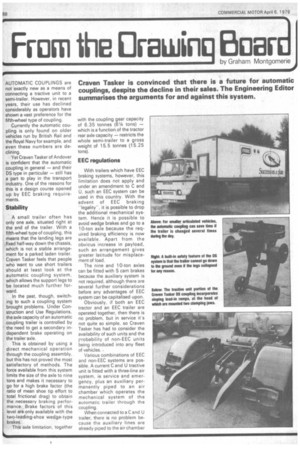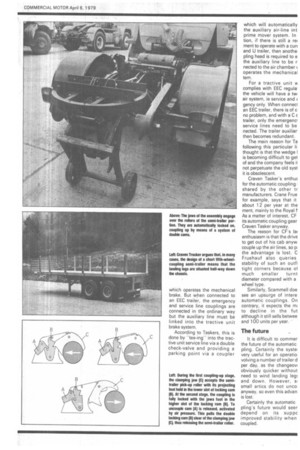It From the Drawing pp@Fd
Page 90

Page 91

If you've noticed an error in this article please click here to report it so we can fix it.
, „,ore
Craven Tasker is convinced that there is a future for automatic couplings, despite the decline in their sales. The Engineering Editor summarises the arguments for and against this system.
AUTOMATIC COUPLINGS are not exactly new as a means of connecting a tractive unit to a semi-trailer. However, in recent years, their use has declined considerably as operators have shown a vast preference for the fifth-wheel type of coupling.
Currently the automatic coupling is only found on older vehicles run by British Rail and the Royal Navy for example, and even these numbers are declining.
Yet Craven Tasker of Andover is confident that the automatic coupling in general — and their DS type in particular — still has a part to play in the transport industry. One of the reasons for this is a design course opened up by EEC braking requirements.
Stability
A small trailer often has only one axle, situated right at the end of the trailer. With a fifth-wheel type of coupling, this means that the landing legs are fixed half-way down the chassis, which is not a stable arrangement for a parked laden trailer. Craven Tasker feels that people who want to use short trailers should at least look at the automatic coupling system, which allows the support legs to be located much further forward.
In the past, though, switching to such a coupling system brought problems. Under Construction and Use Regulations, the axle capacity of an automatic coupling trailer is controlled by the need to get a secondary independent brake operating on the trailer axle.
This is obtained by using a direct mechanical operation through the coupling assembly, but this has not proved the most satisfactory of methods. The force available from this system limits the size of the axle to nine tons and makes it necessary to go for a high brake factor (the ratio of mean shoe tip effort to total frictional drag) to obtain the necessary braking performance.. Brake factors of this level are only available with the two-leading-shoe wedge-type brakes.
This axle limitation, together
with the coupling gear capacity of 6.35 tonnes (61/4 tons) — which is a function of the tractor rear axle capacity — restricts the whole semi-trailer to a gross weight of 15.5 tonnes (15.25 tons).
EEC regulations
With trailers which have EEC braking systems, however, this limitation does not apply and under an amendment to C and U, such an EEC system can be used in this country. With the advent of EEC braking "legality'', it is possible to drop the additional mechanical system. Hence it is possible to avoid wedge brakes and go to a 10-ton axle because the required braking efficiency is now available. Apart from the obvious increase in payload, such an arrangement gives greater latitude for misplacement of load.
The nine and 10-ton axles can be fitted with S cam brakes because the auxiliary system is not required, although there are several further considerations' before any advantages of EEC system can be capitalised upon.
Obviously, if both an EEC tractor and an EEC trailer are operated together, then there is no problem, but in service it's not quite so simple, so Craven Tasker has had to consider the availability of such units and the probability of non-EEC units being introduced into any fleet of vehicles.
Various combinations of EEC and non-EEC systems are possible. A current C and U tractive unit is fitted with a three-line air system, ie service and emergency, plus an auxiliary permanently piped to an air chamber which operates the mechanical system of the automatic trailer through the coupling.
When connected to a C and U trailer, there is no problem because the auxiliary lines are already piped to the air chamber which operates the mechanical brake. But when connected to an EEC trailer, the emergency and service line couplings are connected in the ordinary way but the auxiliary line must be linked into the tractive unit brake system.
According to Taskers, this is done by "tee-ing" into the tractive unit service line via a double check-valve and providing a parking point via a coupler
which will automatically the auxiliary air-line int prime mover system. In tion, if there is still a rei ment to operate with a cun and U trailer, then anothe pling head is required to e the auxiliary line to be r nected to the air chamber 1 operates the mechanical tern.
For a tractive unit ■..) complies with EEC regula. the vehicle will have a tw. air system, ie service and gency only. When connect an EEC trailer, there is of c no problem, and with a C z trailer, only the emergenc. service lines need to be nected. The trailer auxiliar then becomes redundant.
The main reason for Ta following this particular Ii thought is that the wedge I is becoming difficult to get of and the company feels ii not perpetuate the old syst it is obsolescent Craven Tasker's enthuf for the automatic coupling shared by the other tr manufacturers. Crane Frue for example, says that it about 12 per year at the ment mainly to the Royal P As a matter of interest, CF its automatic coupling gear Craven Tasker anyway.
The reason for CF's lai enthusiasm is that the drive to get out of his cab anyw couple up the air lines, so p. the advantage is lost. C Fruehauf also queries stability of such an outfi tight corners because oi much smaller turnt diameter compared with a wheel type.
Similarly, Scammell doe see an upsurge of intere automatic couplings. On contrary, it expects the rm to decline in the fut although it still sells betwee and 100 units per year. •
The future
It is difficult to commer the future of the automatic piing. Certainly the syste very useful for an operatio volving a number of trailer d per day, as the changeovi obviously quicker without need to wind landing leg: and down. However, s. small artics do not unco anyway, so even this advan is lost.
Certainly the automatic pling's future would seer depend on its suppc improved stability when coupled.




































































































































































